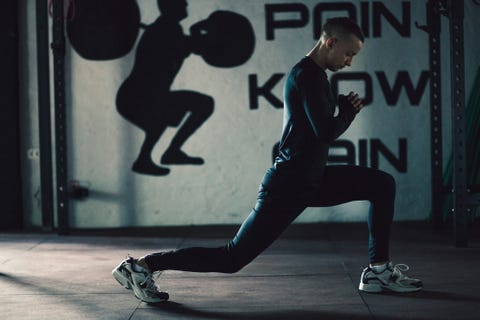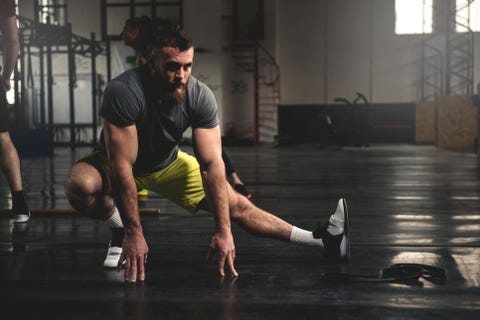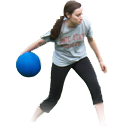
Start With a Dynamic Warm-up For Better Workout Results
If you want to make serious gains, take the time to get properly prepped.

There was a time when a lifter would walk into the gym, do a few shoulder rolls to loosen up, crack his knuckles, and start bench pressing. That time is now past, and, for the record, those lifters probably all have shoulder injuries.
We get it—when you’re anxious to train, you don’t want to do a whole yoga routine before you get to touch a barbell. But, failing to warm up can cost you dearly, both in terms of the safety of your session and its effectiveness.
A dynamic warmup is one that has you moving in similar ways to the exercises you plan to perform, so it prepares you specifically for the tasks ahead. Other means of warming up—such as a light treadmill jog to break a sweat or static stretching (stretch a muscle and hold it)—can raise your core temperature and help you limber up, but they don’t fully prepare your muscles, joints, and nervous system to lift weights. A good dynamic warmup includes aspects of cardiovascular training, strength, mobility, and power, and can be done in just a few minutes—without draining your enthusiasm to lift or making you look foolish.
How to Do a Dynamic Warmup
If you can spare 5 minutes, go to the treadmill or exercise bike, and walk on an incline or pedal at a moderate pace. This is just to raise your core temperature and help you to sweat. “We have a greater capacity to move through ranges when the body is hot,” says trainer Sam Pogue. This is an especially good idea when you’re training first thing in the morning or on a cold day, but if you don’t have the time, or you want to go straight into warming up your muscles directly, find the stretching area or any other open space and pick up a foam roller or other self-myofascial release tool.
Begin rolling around your hips. Aim specifically for your tensor fascia latae, a muscle that lies on the side of your hip, extending halfway down the side of your thigh, and your piriformis, which lies behind your glutes, roughly halfway between the side of your hip bone and the inside edge of your butt cheek. You’ll know when you’ve found them, because they will be tender (especially your piriformis). According to Pogue, these muscles are “chronically tight” on just about everyone, due to excessive sitting, and they also play a major role in keeping the pelvis in the proper position during exercises, so it’s important to get them to relax and be able to move better before you begin training.
Next, roll out your mid back (thoracic spine). If you sit at a desk all day, it’s sure to be tight, and that restricts your ability to do a variety of movements safely and efficiently, including any pressing, pulling, or rotation you have planned for your workout.

Roll the length of these muscles slowly, up and down, spending 30 seconds on each. Linger over any areas that feel especially tender, taking a deep breath and letting it out slowly, to encourage greater relaxation. If your hamstrings, quads, lats, or other areas are feeling particularly tight, you’re welcome to roll those out as well, but Pogue cautions that rolling has a relaxing effect on the body, down-regulating your nervous system into a parasympathetic state. This is the mode known as rest and digest—the opposite of fight or flight—in which your body wants to recover. In other words, in order to stay alert and amped to train, go easy on the rolling, and use it only to release tension in your tightest areas. Doing too much will take you out of the headspace needed to attack the weights, and can actually make you sleepy.
Move on to Mobility
At this point, you’re ready to move. The term mobility refers to your ability to control your body through the ranges of motion that are available to you in a particular movement pattern. It’s not the same as flexibility, which implies that you can take your joints through a certain range of motion, but not necessarily control your body in that range. Think of it this way: If you can squat down till your butt touches your calves with perfect form, you have great mobility; if your chest falls forward, your lower back rounds, and your heels come off the floor, you merely have some flexibility in your hamstrings. To develop mobility, you need more than stretching; you need exercises that force you to stabilize some parts of your body, while others move.
Pogue recommends the following ultra-minimalist mobility routine found in the Men’s Health Encyclopedia of Muscle, which provides one drill per major joint complex. Not only do these exercises prepare you to go through the ranges of motion you’ll use in your workout but also they double as an assessment.

“Think of them as a way to check in, and see how your body feels,” says Pogue. Depending on how you’re moving and which movements feel smooth versus uncomfortable, you can customize your workout on the spot for the best results, while reducing the risk of injury. “It may be bench-press day, but, if you discover that your elbows feel like crap, you may want to use dumbbells instead, or avoid pressing entirely,” he says. You can also use this series before any cardio you do, and on off-days to improve mobility further.
Perform 5 to 10 reps for each exercise, unless otherwise directed. Begin every standing movement from a neutral position: Stand with your feet hip-width apart, a slight bend in your knees, and your shoulders back and down—think proud chest. Stand tall and actively reach for the floor with your fingertips. Tuck your tailbone so that your pelvis is parallel to the floor, and brace your core so that your ribs stay down (not flaring). Retract your neck so that your head is in line with your spine—your chin shouldn’t jut out.




